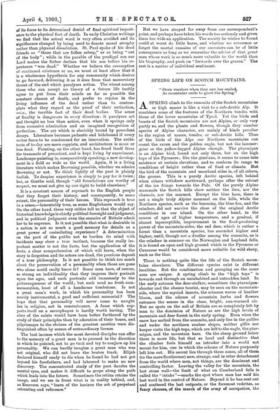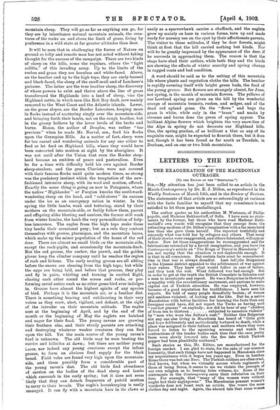SPRING LIFE ON SCOTCH MOUNTAINS.
"Stern warriors when they saw her smiled, Is mountains smile to greet the Spring."
ASPRING climb to the summits of the Scotch mountains or high moors is like a visit to a sub-Arctic Alp. It combines some of the features of the Northern tundra with those of the lower mountains of Tyrol. Yet the birds and beasts of the Scotch mountains are not Alpine, or only very partly so, and the plants and flowers, though they number species of Alpine character, are mainly of kinds peculiar to the region of moors, tundra, or sub-Arctic hills. Thus of the birds of the Alps our Northern mountains can count the raven and the golden eagle, but not the la.mmer- geier or the yellow-legged Alpine chough. The ptarmigan is an Alpine bird, found not only there, but on the high tops of the Pyrenees ; like the gentians, it seems to come into existence at certain elevations, and to conform its range to conditions of height rather than of food or climate. But the bird of the mountain and moorland sides is, of all others, the grouse. This is a purely Arctic species, left behind when others withdrew northward, perhaps after the retreat of the ice fringe towards the Pole. Of the purely Alpine mammals the Scotch hills show neither the ibex, nor the chamois, nor the marmot. Except the blue hare, there is not a single truly Alpine mammal on the hills, while the Northern species, such as the lemming, the blue fox, and the reindeer, did not survive the close of the original Arctic conditions in our island. On the other hand, in the course of ages of higher temperature, and a gradual, if almost inperceptible, improvement in the food-producing power of the mountain-sides, the red deer, which is rather a forest than a mountain species, has ascended higher and higher, until, though not a dweller among the summits, as is the reindeer in summer on the Norwegian and Lapland fells, it is found on open and high ground which in the Pyrenees or Caucasus would be considered more suitable for wild sheep, such as the thar.
There is nothing quite like the life of the Scotch moun- tains elsewhere. The different species exist in different localities. But the combination and grouping on the same area are unique. A spring climb to the "high tops" is towards and through an uninhabited and untrodden laud. In the early autumn the deer-stalker, sometimes the ptarmigan- shooter and the chance tourist, may be seen on the mountain- side, where the myriad insects, the crimson waves of heather bloom, and the odours of mountain herbs and flowers entrance the senses in the clear, bright, sun-warmed air. But no spots on the soil of Britain are so completely left by man to the dominion of Nature as are the high levels of mountain and deer forest in the early spring. Even when the snow has melted from the summits, and only lies in the gullies and under the northern sunless slopes, neither gillie nor keeper visits the high tops, which are left to the eagle, the ptar- migan, and the mountain hare. On the sheep ground below there is more life, but that so local and distinctive that the climber feels himself an intruder into a world not meant for him, one in which the scheme of Nature purposely left him out. His ascent lies through three zones, all of them (to the mere Southerner) new, strange, and in utter detachment from the world where men, not things, are the dominant and controlling factor. Leaving the valley for the mountain, the last stone wall—the limit of what on Cumberland fells is called the "intake "—marks the spot where man has said his last word in the control of Nature. Beyond it he has sent out and scattered the last outposts, or the foremost vedettes, as fancy chooses, of the march of the army of occupation, the
mountain sheep. They will go as far as anything can go, for they are by inheritance natural mountain animals, the crea- tures of the rocks on and above.the limit of grass, living by preference in a wild state at far greater altitudes than deer.
It will be seen that in challenging the forces of Nature on ground so lofty and remote man has not acted without taking thought for the success of the campaign. There are two kinds of -sheep 'on the hills, some the regulars, others the "light militia," of this invading army. Up to the limits of the rashes and grass they are hornless and white-faced. Above, on the heather and up to the high tops, they are curly-horned and black-faced, the sheep of the snuff-mull and of Landseer's pictures. The latter are the true heather sheep, the discovery of whose powers to exist and thrive above the line of grass transformed the Highlands into a land of sheep, vice the Highland cattle, in which men like Rob Roy dealt, now mainly removed to the West Coast and the Atlantic islands. Lower, on the grass slopes, are the Border Leicesters, keeping more in flocks instead of scattering singly over the mountain-side, and bringing forth their lambs, not on the rough heather, but in the grassy hollows by the lower levels of the becks and burns. Home, the author of Douglas, was rather "too previous" when he made Mr. Norval, sen., feed his flocks upon the Grampian Hills. As a matter of fact, sheep were far too casual and wandering animals for any one either to feed or let feed on Highland hills, where they would have been converted into mutton at sight by the aborigines. It was not until after the Union that even the Border shep- herd became an emblem of peace and pastoralism. Even he for a time with difficulty held his own against Border sheep-stealers; and the green Cheviots were not covered with their famous flocks until quite modern times, so strong was the predatory instinct which the temptation of the new- fashioned intrusive sheep, with its wool and mutton, offered. Exactly the same thing is going on now in Patagonia, where the native " Highlander " or Fuegian knocks the southward- wandering sheep on the head, and," cold-stores" its carcase under the ice as an emergency ration in winter. In the spring the little lambs, weak and tottering, stand by their mothers on the mountain-side, or feebly follow them, parent and offspring alike bleating and anxious, the former still weak from winter famine, the lamb the very personification of help- less innocence. The eagles from the high tops make these tiny lambs their occasional prey; but as a rule they content themselves with grouse, ptarmigan, and the mountain hares, which make up the minor population of the home of the red deer. There are almost no small birds on the mountain-side, except the rock-pipits, and occasionally the mountain-finch. But the red grouse, the curlew, the peewit, and the golden plover keep the climber company until he reaches the region of rock and lichens. The early nesting grouse are all sitting before the snows are clearing from the high tops; but while the eggs are being laid, and before that process, they play and fly in pairs, whirling and turning in excited flight, chasing each other round the screes and rocks, or per- forming aerial antics such as no other game bird ever indulges in. Grouse have almost the highest spirits of any species of bird. Perhaps it is the mountain air, or a heather diet. There is something bracing and exhilarating in their very voices as they crow, alert, vigilant, and defiant, at the sight of, the intruder on their mountain solitude. The eagles nest at the beginning of April, and by the end of the month or the beginning of . May the eaglets are batched and eager for their food. The young ravens are growing their feathers also, and their sturdy parents are attacking and destroying whatever weaker creatures they can find upon the hill. Yet the main source of the young raven's food is unknown. The old birds may be seen beating the conies and hillsides at dawn ; but there are neither young hares, nor indeed any young creatures except the infant grouse, to form an obvious food supply for the black brood. Field voles are found very high upon the mountain- side, and these possibly ,form a considerable part of the young raven's diet. The old birds find abundance of carrion on the bodies of the dead sheep and lambs which ,succumb in the early spring; but it does not seem likely that they can detach fragments of putrid mutton to carry ,to their broods. The eagles housekeeping is easily managed. It can fly with a mountain hare in its claws as easily as a sparrowhawk carries a chaffinch, and the eaglets grow up mainly on hare in various forms, torn up and made ready for nursery use on the spot by their affectionate parents. The visitor to these solitudes, if they be deer forests, might think at first that the hill carried nothing but hinds. Nor will.he be greatly impressed by the appearance of the deer, if he succeeds in approaching them. The reason is that the stags have shed their antlers, while both they and the hinds are showing the effects of winter scarcity and spring change in ragged coats and bad condition.
A word should be said as to the setting of this mountain life where plants and vegetation clothe the hills. The heather is rapidly covering itself with bright green buds, the food of the young grouse. But flowers are strangely absent, for June, not spring, is the month of mountain flowers. The yellows of our Lowland spring are given on the bill by the wonderful orange of mountain bennets, rushes, and sedges, and of the dead red upland grass. On the " flows " and bogs the grass is white, while only in the " braes " and nooks by streams and burns does the green of spring appear. The brilliant Alpine flowers which brighten the very snow-line of the Alps in spring do not decorate our Highland hills. One, the spring gentian, of as brilliant a blue as any of its exquisite race, might be expected to flourish there, but it does not, though it has been found as far south as Teesdale, in Durham, and on one or two Irish mountains.











































 Previous page
Previous page